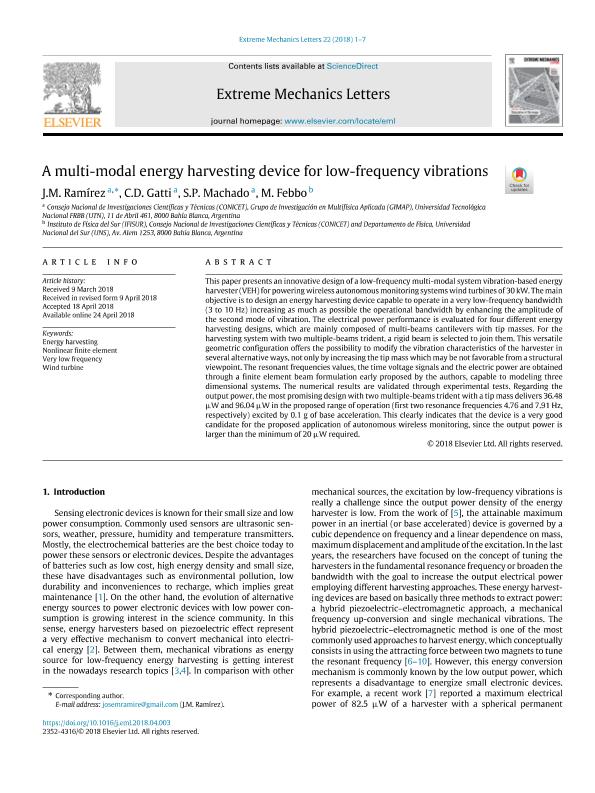Mostrar el registro sencillo del ítem
dc.contributor.author
Ramírez, J.M.
dc.contributor.author
Gatti, Claudio David

dc.contributor.author
Machado, Sebastián Pablo

dc.contributor.author
Febbo, Mariano

dc.date.available
2020-01-07T17:56:01Z
dc.date.issued
2018-07
dc.identifier.citation
Ramírez, J.M.; Gatti, Claudio David; Machado, Sebastián Pablo; Febbo, Mariano; A multi-modal energy harvesting device for low-frequency vibrations; Elsevier Ltd; Extreme Mechanics Letters; 22; 7-2018; 1-7
dc.identifier.issn
2352-4316
dc.identifier.uri
http://hdl.handle.net/11336/93825
dc.description.abstract
This paper presents an innovative design of a low-frequency multi-modal system vibration-based energy harvester (VEH) for powering wireless autonomous monitoring systems wind turbines of 30 kW. The main objective is to design an energy harvesting device capable to operate in a very low-frequency bandwidth (3 to 10 Hz) increasing as much as possible the operational bandwidth by enhancing the amplitude of the second mode of vibration. The electrical power performance is evaluated for four different energy harvesting designs, which are mainly composed of multi-beams cantilevers with tip masses. For the harvesting system with two multiple-beams trident, a rigid beam is selected to join them. This versatile geometric configuration offers the possibility to modify the vibration characteristics of the harvester in several alternative ways, not only by increasing the tip mass which may be not favorable from a structural viewpoint. The resonant frequencies values, the time voltage signals and the electric power are obtained through a finite element beam formulation early proposed by the authors, capable to modeling three dimensional systems. The numerical results are validated through experimental tests. Regarding the output power, the most promising design with two multiple-beams trident with a tip mass delivers 36.48 μW and 96.04 μW in the proposed range of operation (first two resonance frequencies 4.76 and 7.91 Hz, respectively) excited by 0.1 g of base acceleration. This clearly indicates that the device is a very good candidate for the proposed application of autonomous wireless monitoring, since the output power is larger than the minimum of 20 μW required.
dc.format
application/pdf
dc.language.iso
eng
dc.publisher
Elsevier Ltd
dc.rights
info:eu-repo/semantics/openAccess
dc.rights.uri
https://creativecommons.org/licenses/by-nc-sa/2.5/ar/
dc.subject
ENERGY HARVESTING
dc.subject
NONLINEAR FINITE ELEMENT
dc.subject
VERY LOW FREQUENCY
dc.subject
WIND TURBINE
dc.subject.classification
Mecánica Aplicada

dc.subject.classification
Ingeniería Mecánica

dc.subject.classification
INGENIERÍAS Y TECNOLOGÍAS

dc.title
A multi-modal energy harvesting device for low-frequency vibrations
dc.type
info:eu-repo/semantics/article
dc.type
info:ar-repo/semantics/artículo
dc.type
info:eu-repo/semantics/publishedVersion
dc.date.updated
2019-10-22T17:29:21Z
dc.journal.volume
22
dc.journal.pagination
1-7
dc.journal.pais
Países Bajos

dc.journal.ciudad
Amsterdam
dc.description.fil
Fil: Ramírez, J.M.. Universidad Tecnológica Nacional; Argentina
dc.description.fil
Fil: Gatti, Claudio David. Universidad Tecnológica Nacional; Argentina
dc.description.fil
Fil: Machado, Sebastián Pablo. Universidad Tecnológica Nacional; Argentina
dc.description.fil
Fil: Febbo, Mariano. Consejo Nacional de Investigaciones Científicas y Técnicas. Centro Científico Tecnológico Conicet - Bahía Blanca. Instituto de Física del Sur. Universidad Nacional del Sur. Departamento de Física. Instituto de Física del Sur; Argentina
dc.journal.title
Extreme Mechanics Letters
dc.relation.alternativeid
info:eu-repo/semantics/altIdentifier/url/http://linkinghub.elsevier.com/retrieve/pii/S2352431618300361
dc.relation.alternativeid
info:eu-repo/semantics/altIdentifier/doi/http://dx.doi.org/10.1016/j.eml.2018.04.003
Archivos asociados
